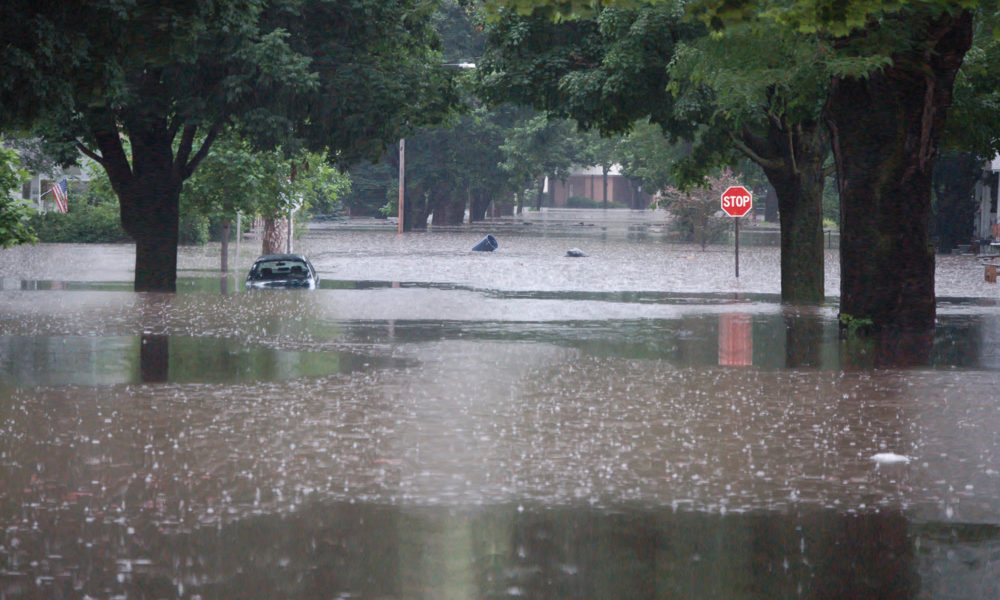The new Biden administration has been in place not quite two months and we’ve already seen ambitious Executive Orders on climate change. This is a welcome breath of fresh air and a stark contrast to the last four years. For example, on day one President Biden signed the Executive Order on Protecting Public Health and the Environment and Restoring Science to Tackle the Climate Crisis and on January 27th signed the Executive Order on Tackling the Climate Crisis at Home and Abroad. These executive orders (EO) include a wealth of provisions that will upright the country’s direction on climate change.
A key question now on my mind is how quickly this clear signal on the urgency to act on climate change will trickle down to the federal agencies that need to implement the policy provisions.
Is climate change filtering down into FEMA under the new Administration?
This week, the Federal Emergency Management Agency’s (FEMA) Technical Mapping Advisory Committee (TMAC) met for the first time under the Biden administration. (Actually, one could argue it was the second meeting as the last TMAC two-day meeting was held the day before and day of Biden’s inauguration). While TMAC may sound like an obscure committee and not relevant to the layperson, it is the science-based technical committee established by the Biggert-Waters Flood Insurance Reform Act of 2012, that provides critical, up to date science and technical guidance to FEMA on flood risk and mapping.
President Biden has set an important shift in tone via his executive orders on climate change. It’s too soon in the early days of this administration to assess whether this guidance is filtering down to agencies comprehensively. However, to live into the whole-of-government approach, agencies need to change quickly to integrate climate change into their missions as Biden is championing.
Here are my public comments that provide a synopsis of the varied experience over the two-day period and recommendations to FEMA and TMAC regarding TMAC’s 2020 report and FEMA’s 2021 tasking memo. My comments on TMAC’s 2020 report speak to the difficulty in reviewing a document for the first time live online (check FEMA’s website to see if the report has been posted) as well as the lack of explicit integration of climate change. After my comments, I learned that there were sprinklings of the term in the 2020 annual report. Nonetheless, I gathered a lack of integration of climate change within all aspects of the report – from the vision statement to the discussion of future conditions, the figures and graphics, public engagement, etc. Given that the TMAC was finalizing a summary of the work they did in 2020, the first day felt as though the proceedings were happening under the past administration. In sharp contrast, day two was clear evidence of FEMA and TMAC fully embracing the Biden administrations’ climate change commitment.
“With this administration, we can actually say climate change” says FEMA’s Michael Grimm
Then there’s day two of the TMAC meeting when the TMAC members were eagerly anticipating FEMA’s 2021 tasking memo presentation by Michael Grimm. As Mr. Grimm began to give an overview of the tasks, he seemed relieved to be able to ground the conversation with the statement “With this administration, we can actually say climate change.” Yes, after four years of that past administration’s sideling climate science, the TMAC seems ready to roll up its sleeves and dig in on integrating climate change projections into their 2021 work plan. The three bucket areas of work include: 1) continue engaging with external stakeholders; 2) review recommendations from the TMAC’s 2015 Future Conditions report; and 3) explore Risk Management Frameworks.
Task One directs TMAC to continue engaging with external stakeholders and consider six questions.
 The questions seek input from TMAC on how FEMA can solicit input from stakeholders on moving toward graduated flood hazard and risk data under FEMA’s Risk Rating 2.0 (RR 2.0) program. The Congressional Research Service (CRS) provided an excellent overview of FEMA’s effort to move the National Flood Insurance Program’s insurance rating system away from the binary (in or out of the “100-year” floodplain) to a probabilistic approach (individual property premiums will be tied to their actual flood risk).
The questions seek input from TMAC on how FEMA can solicit input from stakeholders on moving toward graduated flood hazard and risk data under FEMA’s Risk Rating 2.0 (RR 2.0) program. The Congressional Research Service (CRS) provided an excellent overview of FEMA’s effort to move the National Flood Insurance Program’s insurance rating system away from the binary (in or out of the “100-year” floodplain) to a probabilistic approach (individual property premiums will be tied to their actual flood risk).
CRS’s Diane Horn wrote: “FEMA is planning to introduce the biggest change to the way the NFIP calculates flood insurance premiums, known as Risk Rating 2.0, since the inception of the NFIP in 1968.”
My comments touched on how it’s critical that FEMA and TMAC design an engagement process that is transparent, equitable, and includes affordability provisions. I stressed that the engagement and education must flow both ways – collecting information from stakeholders but also educating and providing information to stakeholders – the latter seems to need to be built out more substantially. Reaching and engaging the public before the new premium rates are set to go into effect on October 21, 2021 will be challenging especially as communities and businesses are recovering from compound and cascading impacts from COVID-19 and a record year of costly extreme weather and climate change-related disasters. A longer transitions pathway will allow for more time to engage and educate the public and Congressional member who need to provide FEMA with the direction to establish an affordability program.
To ensure that the historically disadvantaged and low- and fixed income communities are not sidelined, FEMA and the TMAC in coordination with the National Advisory Council (NAC), should develop a subcommittee on social vulnerability and equity and invite subject matter experts (SME) in this issue area to help focus outreach efforts on those communities that are at high risk, have been disproportionately disadvantaged, and have few resources to adapt to changing conditions.
To further smooth this path to RR 2.0, FEMA should task TMAC to work with FEMA consultants to conduct a rapid pilot case study that provides examples of what the new graduated risk approach would look like in practice. This pilot study should:
- showcase real world examples of ratings, based on homes in zip codes from both urban and rural areas in riverine and coastal communities and communities of different income and vulnerability levels.
- anonymize the data so as not to target any specific community or individual household but still provide the public with a real-time snapshot.
By executing such a pilot case study, FEMA will help provide timely education on RR 2.0 to the public sector and congress. Additionally, such a pilot study would help FEMA to entertain input from stakeholders and be in listening mode to hear about any changes that might be needed or improvements to the program based on this real-world experience. This type of study and engagement process will help FEMA to gain support from the public and congress both of which are so critical for the lifespan and success of RR 2.0.
Task Two directs TMAC to address outstanding recommendations from TMAC’s 2015 Future Conditions report.

While some work may have been done on the TMAC’s 2015 Future conditions: Risk assessment and modeling report, addressing the outstanding recommendations in the report is overdue and very much welcome. The Biggert-Waters Flood Insurance Reform Act of 2012 that established TMAC also directed TMAC to develop recommendations for incorporating the best available climate science in flood insurance studies and maps and consider the impacts of sea level rise and future development on flood risk.
On reviewing the 2015 report recommendations, I found at least seven that the TMAC ought to address, including the need for FEMA to develop guidance on local zoning, scenario approaches, advisory maps, and regulations.
Regarding guidance and regulations, TMAC should prioritize guidance on the agencies implementation of the Federal Flood Risk Management Standard (FFRMS) that President Biden restored in the comprehensive Executive Order issued on day one. Specifically, TMAC ought to prioritize advancing technical guidance for riverine areas under climate change projections.
Task Three directs TMAC to explore risk management frameworks.

This task asks TMAC to explore how FEMA could apply Enterprise Risk management (ERM) for flood risk management (FRM). What does that mean exactly and where did it come from? Good question! The notion of ERM in the federal government stems from the Office of Management and Budget (OMB) Circular No. A-123 released in 2016. The ERM directive emphasized the importance of risk management agency-wide to move away from addressing risks in silos.
So, what will an ERM approach for FEMA and TMAC look like? The Government Accountability Office (GAO), the watch dogs of the US government, have an idea. On March 2, GAO released their High-Risks Series report: “Dedicated Leadership Needed to Address Limited Progress in Most High-Risk Areas.”
GAO has many recommendations on how FEMA must more robustly address risks from climate change, including:
- The Secretary of the Department of Homeland Security (DHS) should “direct FEMA to consider amending the floodplain management minimum standards to incorporate forward-looking requirements, similar to the minimum flood risk reduction standard adopted by the Hurricane Sandy Rebuilding Task Force.”
- FEMA needs “metrics and milestones to assess its progress incorporating future conditions into flood map products and for certain actions to improve resilience.”
- FEMA and its partners must revise the National Mitigation Investment Strategy to plan for disaster resilience investment by “explicitly address future climate change risks or include a strategic approach to identify and prioritize specific climate resilience projects for federal investment.”
- FEMA needs to implement a comprehensive strategy “to identify and prioritize FEMA and the federal government’s climate resilience investments to help reduce federal fiscal exposure.
It’s worth reading the GAO’s High-Risks report in its entirety. My question is, will TMAC’s exploration of ERM as well as the public engagement and future conditions tasks advance FEMA’s efforts sufficiently for 2021? I’m hopeful on this front. But many of these policies have been in place for decades without much substantial change, so the challenges are very real. FEMA will need a concerted effort to bring the public and Congress along with them to help move towards the transformational change that’s needed.
FEMA in 2021 and Beyond
What’s clear after these past two days is that FEMA and TMAC will embrace the new priorities under the Biden administration moving forward. TMAC’s expertise will help FEMA meet many of the goals in the 2021 tasking memo and hopefully the outstanding issues in in the GAO report. But FEMA has their work cut out for them. In my comments I described how changing climate conditions are causing negative and worrisome trends in extreme events and disasters. Yet our regulations and standards are insufficient to stop building in flood zones or ensure new construction is built to future climate change projections. The good news is, President Biden’s whole-of-government approach to the climate-crisis ought to provide the leadership, support and resources to FEMA and TMAC as they work to move flood risk management into the 21st century.

